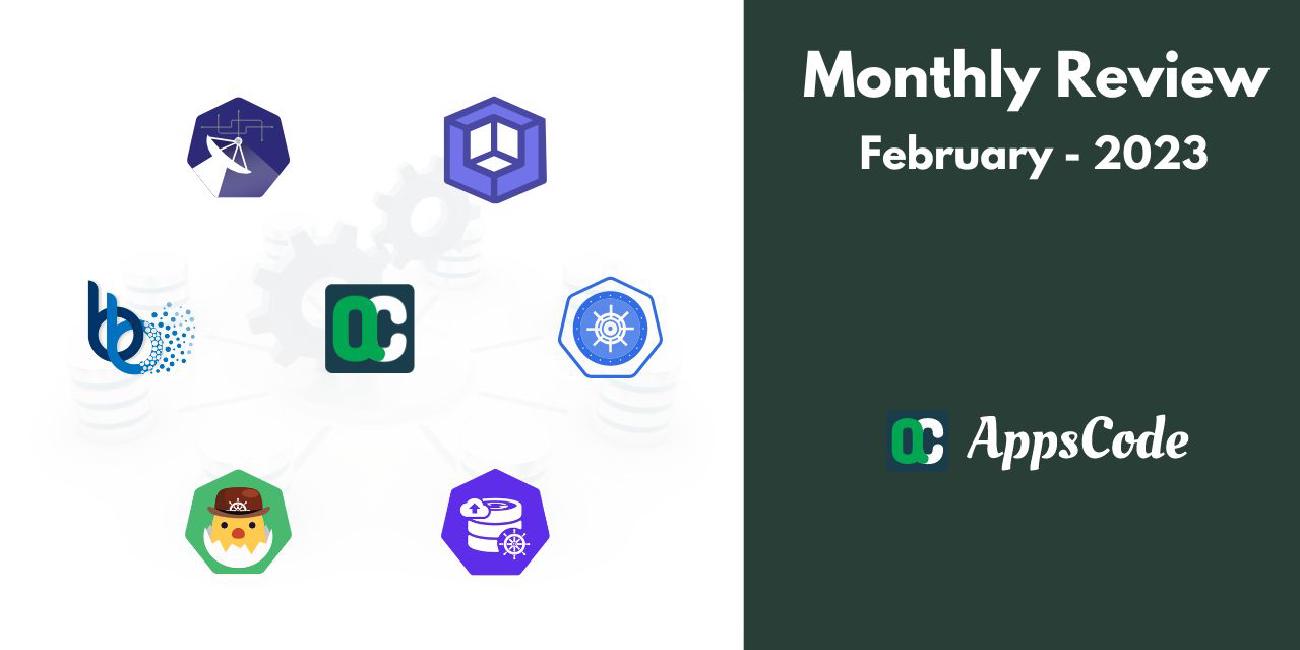
Releases
Announcing KubeDB v2023.02.28
We are pleased to announce the release of KubeDB v2023.02.28. This post lists all the major changes done in this release since the last release. The release includes new features Combined PEM Certificate PostgreSQL Standalone to High Availibility, ACME Protocol based certificate support for ProxySQL & PgBouncer and new verisons for MySQL:8.0.32, 5.7.41, OpenSearch 2.0.1, 2.5.0, Redis: 6.0.18, 6.2.11, 7.0.9.
Link: https://appscode.com/blog/post/kubedb-v2023.02.28/
Introducing Stash v2023.02.28
We are announcing Stash v2023.02.28 which includes a few bug fixes. In this post, we are going to highlight the changes.
Link: https://appscode.com/blog/post/stash-v2023.02.28/
Announcing Voyager v2023.02.22
We are pleased to announce the release of Voyager v2023.02.22. In this release, we have updated HAProxy image to 2.6.9 and fixed various bugs. In this post, we are going to highlight the changes.
Link: https://appscode.com/blog/post/voyager-v2023.02.22/
Webinars
MariaDB and Percona-XtraDB Support for KubeDB ProxySQL, ProxySQL Dashboard & Alerts
AppsCode held a webinar on “MariaDB and Percona-XtraDB Support for KubeDB ProxySQL, ProxySQL Dashboard & Alerts” on 1st February 2023. The contents discussed on the webinar:
- MariaDB and Percona-XtraDB backend support for KubeDB ProxySQL
- Grafana dashboard for KubeDB ProxySQL
- Prometheus alerts for KubeDB ProxySQL
- Q&A session
Link: https://appscode.com/blog/post/proxysql-webinar-2023.02.01/
Blogs Published
Redis - A Powerful Database Cache Server
As a database cache server, Redis, an open-source in-memory data structure store, has gained popularity. In this post, we’ll analyze the architecture of Redis, its important features, and actual use cases for data caching in web applications.
Link: https://appscode.com/blog/post/redis-a-powerful-database-cache-server/
Deploy and Manage MySQL InnoDB Cluster in Amazon Elastic Kubernetes Service (Amazon EKS) using KubeDB
KubeDB simplifies Provision, Upgrade, Scaling, Volume Expansion, Monitor, Backup, Restore for various Databases in Kubernetes on any Public & Private Cloud. This blog shows how to Deploy and Manage MySQL InnoDB Cluster in Amazon Elastic Kubernetes Service (Amazon EKS) using KubeDB.
Link: https://appscode.com/blog/post/deploy-and-manage-mysql-innodb-cluster-in-aws/
Choose Between SQL or NoSQL Database for Your System
Databases are a fundamental component of modern software applications, Providing a foundation for data storage, management, and retrieval. Two primary types of databases used in modern applications are SQL and NoSQL. Here we have a detailed overview of both types of databases.
Link: https://appscode.com/blog/post/choose-between-sql-or-nosql-database/
Deploy and Manage MongoDB Sharded Cluster in Amazon Elastic Kubernetes Service (Amazon EKS) using KubeDB
KubeDB simplifies Provision, Upgrade, Scaling, Volume Expansion, Monitor, Backup, Restore for various Databases in Kubernetes on any Public & Private Cloud. This blog shows how to Deploy and Manage MongoDB Sharded Cluster in Amazon Elastic Kubernetes Service (Amazon EKS) using KubeDB.
Link: https://appscode.com/blog/post/deploy-and-manage-mongodb-sharded-cluster-in-aws-eks/
Exploring the Capabilities of Elasticsearch Database
Elasticsearch is a highly scalable, open-source search engine built to manage large amounts of data. It has several different functions, including full-text search, structured search, analytics, logging, and can be used in a variety of applications and use cases. Here we give an overview of the Elasticsearch database.
Link: https://appscode.com/blog/post/exploring-capabilities-of-elasticsearch-database/
Deploy and Manage Redis in Sentinel Mode in Google Kubernetes Engine (GKE)
KubeDB simplifies Provision, Upgrade, Scaling, Volume Expansion, Monitor, Backup, Restore for various Databases in Kubernetes on any Public & Private Cloud. This blog shows how to Deploy and Manage Redis in Sentinel Mode in Google Kubernetes Engine (GKE) Using KubeDB.
Link: https://appscode.com/blog/post/deploy-and-manage-redis-sentinel-in-gke/
Connect AWS EKS Clusters with Submariner
Submariner is a CNCF sandbox project which can enable direct networking between Pods and Services in different Kubernetes clusters, either on-premises or in the cloud. In this blog post, we are showing how can you connect two AWS EKS Kubernetes clusters with default vpc cni using Submariner.
Link: https://appscode.com/blog/post/connect-eks-clusters-with-submariner/
Support
To speak with us, please leave a message on our website .
To receive product announcements, follow us on [Twitter](https://twitter.com/AppsCodeHQ/ .
Follow our Linkedin for more AppsCode Inc
To watch tutorials of various Production-Grade Kubernetes Tools Subscribe our YouTube channel.









